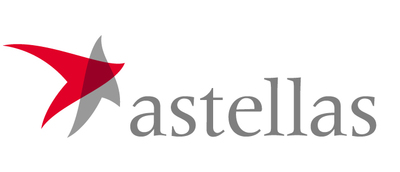You are now leaving XTANDI.com
The website you are about to visit is not owned or controlled by Astellas. Astellas are not responsible for the information or services on this site.
TOKYO, Oct. 31, 2019 /PRNewswire/ -- The New England Journal of Medicine published detailed results from the Phase 3 ADMIRAL trial, which found that Astellas Pharma Inc.'s (TSE: 4503, President and CEO: Kenji Yasukawa, Ph.D. "Astellas") XOSPATA® (gilteritinib) demonstrated significantly longer Overall Survival (OS) than salvage chemotherapy in adult patients with relapsed (disease that has returned) or refractory (resistant to treatment) Acute Myeloid Leukemia (AML) with a FMS-like tyrosine kinase 3 (FLT3) mutation. Common adverse events from the study of grade 3 or higher in the gilteritinib group were febrile neutropenia (45.9%), anemia (40.7%), and thrombocytopenia (22.8%).1 The results appear in the October 31 print edition of the Journal and are currently available online.1

"These data show that in a very high-risk leukemia population, single agent FLT3-targeted therapy leads to superior clinical outcomes compared to salvage chemotherapy," said Alexander Perl, MD, associate professor of Hematology-Oncology in the Abramson Cancer Center at the University of Pennsylvania, and the trial's principal investigator. "This is an important result for patients who previously had quite limited treatment options."
"The detailed findings from our Phase 3 ADMIRAL trial further validate that XOSPATA is a significant addition to the treatments available for people with FLT3 mutation positive relapsed or refractory AML," said Andrew Krivoshik, M.D., Ph.D., Senior Vice President and Oncology Therapeutic Area Head at Astellas. "We are especially pleased to see the results published in the New England Journal of Medicine, which is widely regarded as one of the most prestigious scientific medical journals."
The U.S. Food and Drug Administration (FDA) approved a supplemental New Drug Application (sNDA) in May of 2019 to update the U.S. product labeling for XOSPATA to include final analysis OS data from the ADMIRAL trial.2
XOSPATA was discovered through a research collaboration with Kotobuki Pharmaceutical Co., Ltd., and Astellas has exclusive global rights to develop, manufacture and commercialize XOSPATA.
XOSPATA was approved by the Japan Ministry of Health, Labor and Welfare (MHLW) for relapsed or refractory AML with FLT3 mutations and launched as XOSPATA® 40 mg Tablets in 2018.3 Astellas is currently investigating gilteritinib in various FLT3 mutation-positive AML patient populations through several clinical trials. Visit http://www.clinicaltrials.gov to learn more about ongoing gilteritinib clinical trials.
About the ADMIRAL Trial 4
The Phase 3 ADMIRAL trial (NCT02421939) was an open-label, multicenter, randomized study of gilteritinib versus salvage chemotherapy in adult patients with FLT3 mutations who are refractory to or have relapsed after first-line AML therapy. The co-primary endpoints of the trial were Overall Survival and Complete Remission (CR)/Complete Remission with Partial Hematologic Recovery (CRh). The study enrolled 371 patients with relapsed or refractory AML and positive for FLT3 mutations present in bone marrow or whole blood as determined by the central lab. Subjects were randomized in a 2:1 ratio to receive gilteritinib (120 mg) or salvage chemotherapy.4
About XOSPATA® (gilteritinib) 5
XOSPATA is indicated for the treatment of adult patients who have relapsed or refractory Acute Myeloid Leukemia (AML) with an FMS-like tyrosine kinase 3 (FLT3) mutation as detected by an FDA-approved test.5
Important Safety Information
WARNING: DIFFERENTIATION SYNDROME |
Contraindications
XOSPATA is contraindicated in patients with hypersensitivity to gilteritinib or any of the excipients. Anaphylactic reactions have been observed in clinical trials.
Warnings and Precautions
Differentiation Syndrome (See BOXED WARNING) 3% of 319 patients treated with XOSPATA in the clinical trials experienced differentiation syndrome. Differentiation syndrome is associated with rapid proliferation and differentiation of myeloid cells and may be life-threatening or fatal if not treated. Symptoms of differentiation syndrome in patients treated with XOSPATA included fever, dyspnea, pleural effusion, pericardial effusion, pulmonary edema, hypotension, rapid weight gain, peripheral edema, rash, and renal dysfunction. Some cases had concomitant acute febrile neutrophilic dermatosis. Differentiation syndrome occurred as early as 2 days and up to 75 days after XOSPATA initiation and has been observed with or without concomitant leukocytosis. If differentiation syndrome is suspected, initiate dexamethasone 10 mg IV every 12 hours (or an equivalent dose of an alternative oral or IV corticosteroid) and hemodynamic monitoring until improvement. Taper corticosteroids after resolution of symptoms and administer corticosteroids for a minimum of 3 days. Symptoms of differentiation syndrome may recur with premature discontinuation of corticosteroid treatment. If severe signs and/or symptoms persist for more than 48 hours after initiation of corticosteroids, interrupt XOSPATA until signs and symptoms are no longer severe.
Posterior Reversible Encephalopathy Syndrome (PRES) 1% of 319 patients treated with XOSPATA in the clinical trials experienced posterior reversible encephalopathy syndrome (PRES) with symptoms including seizure and altered mental status. Symptoms have resolved after discontinuation of XOSPATA. A diagnosis of PRES requires confirmation by brain imaging, preferably magnetic resonance imaging (MRI). Discontinue XOSPATA in patients who develop PRES.
Prolonged QT Interval XOSPATA has been associated with prolonged cardiac ventricular repolarization (QT interval). 1% of the 317 patients with a post-baseline QTc measurement on treatment with XOSPATA in the clinical trial were found to have a QTc interval greater than 500 msec and 7% of patients had an increase from baseline QTc greater than 60 msec. Perform electrocardiogram (ECG) prior to initiation of treatment with XOSPATA, on days 8 and 15 of cycle 1, and prior to the start of the next two subsequent cycles. Interrupt and reduce XOSPATA dosage in patients who have a QTcF >500 msec. Hypokalemia or hypomagnesemia may increase the QT prolongation risk. Correct hypokalemia or hypomagnesemia prior to and during XOSPATA administration.
Pancreatitis 4% of 319 patients treated with XOSPATA in the clinical trials experienced pancreatitis. Evaluate patients who develop signs and symptoms of pancreatitis. Interrupt and reduce the dose of XOSPATA in patients who develop pancreatitis.
Embryo-Fetal Toxicity XOSPATA can cause embryo-fetal harm when administered to a pregnant woman. Advise females of reproductive potential to use effective contraception during treatment with XOSPATA and for at least 6 months after the last dose of XOSPATA. Advise males with female partners of reproductive potential to use effective contraception during treatment with XOSPATA and for at least 4 months after the last dose of XOSPATA. Pregnant women, patients becoming pregnant while receiving XOSPATA or male patients with pregnant female partners should be apprised of the potential risk to the fetus.
Adverse Reactions
Fatal adverse reactions occurred in 2% of patients receiving XOSPATA. These were cardiac arrest (1%) and one case each of differentiation syndrome and pancreatitis. The most frequent (≥5%) nonhematological serious adverse reactions reported in patients were fever (13%), dyspnea (9%), renal impairment (8%), transaminase increased (6%) and noninfectious diarrhea (5%).
7% discontinued XOSPATA treatment permanently due to an adverse reaction. The most common (>1%) adverse reactions leading to discontinuation were aspartate aminotransferase increased (2%) and alanine aminotransferase increased (2%).
The most frequent (≥5%) grade ≥3 nonhematological adverse reactions reported in patients were transaminase increased (21%), dyspnea (12%), hypotension (7%), mucositis (7%), myalgia/arthralgia (7%), and fatigue/malaise (6%).
Other clinically significant adverse reactions occurring in ≤10% of patients included: electrocardiogram QT prolonged (9%), hypersensitivity (8%), pancreatitis (5%), cardiac failure (4%), pericardial effusion (4%), acute febrile neutrophilic dermatosis (3%), differentiation syndrome (3%), pericarditis/myocarditis (2%), large intestine perforation (1%), and posterior reversible encephalopathy syndrome (1%).
Lab Abnormalities Shifts to grades 3-4 nonhematologic laboratory abnormalities in XOSPATA treated patients included phosphate decreased (14%), alanine aminotransferase increased (13%), sodium decreased (12%), aspartate aminotransferase increased (10%), calcium decreased (6%), creatine kinase increased (6%), triglycerides increased (6%), creatinine increased (3%), and alkaline phosphatase increased (2%).
Drug Interactions
Combined P-gp and Strong CYP3A Inducers Concomitant use of XOSPATA with a combined P-gp and strong CYP3A inducer decreases XOSPATA exposure which may decrease XOSPATA efficacy. Avoid concomitant use of XOSPATA with combined P-gp and strong CYP3A inducers.
Strong CYP3A inhibitors Concomitant use of XOSPATA with a strong CYP3A inhibitor increases XOSPATA exposure. Consider alternative therapies that are not strong CYP3A inhibitors. If the concomitant use of these inhibitors is considered essential for the care of the patient, monitor patient more frequently for XOSPATA adverse reactions. Interrupt and reduce XOSPATA dosage in patients with serious or life-threatening toxicity.
Drugs that Target 5HT2B Receptor or Sigma Nonspecific Receptor Concomitant use of XOSPATA may reduce the effects of drugs that target the 5HT2B receptor or the sigma nonspecific receptor (e.g., escitalopram, fluoxetine, sertraline). Avoid concomitant use of these drugs with XOSPATA unless their use is considered essential for the care of the patient.
Specific Populations
Lactation: Advise women not to breastfeed during treatment with XOSPATA and for 2 months after the last dose.
Please see Full Prescribing Information including BOXED WARNING for additional safety information.
About Astellas
Astellas Pharma Inc., based in Tokyo, Japan, is a company dedicated to improving the health of people around the world through the provision of innovative and reliable pharmaceutical products. For more information, please visit our website at https://www.astellas.com/en
Cautionary Notes
In this press release, statements made with respect to current plans, estimates, strategies and beliefs and other statements that are not historical facts are forward-looking statements about the future performance of Astellas. These statements are based on management's current assumptions and beliefs in light of the information currently available to it and involve known and unknown risks and uncertainties. A number of factors could cause actual results to differ materially from those discussed in the forward-looking statements. Such factors include, but are not limited to: (i) changes in general economic conditions and in laws and regulations, relating to pharmaceutical markets, (ii) currency exchange rate fluctuations, (iii) delays in new product launches, (iv) the inability of Astellas to market existing and new products effectively, (v) the inability of Astellas to continue to effectively research and develop products accepted by customers in highly competitive markets, and (vi) infringements of Astellas' intellectual property rights by third parties.
Information about pharmaceutical products (including products currently in development) which is included in this press release is not intended to constitute an advertisement or medical advice.
1 Perl A, Martinelli G, Cortes J, et al. Gilteritinib or chemotherapy for relapsed or refractory
FLT3-mutated AML. N Engl J Med 2019; 381:1728-40.
2 U.S. Food and Drug Administration. Xospata sNDA 211349/S-001 approval letter (05-29-2019). https://www.accessdata.fda.gov/drugsatfda_docs/appletter/2019/211349Orig1s001ltr.pdf. Accessed 07-25-2019.
3 Astellas Pharma Inc. Astellas Announces Approval in Japan for XOSPATA® 40 mg Tablets for the Treatment of FLT3mut+ Relapsed or Refractory AML (09-21-2018). https://www.astellas.com/en/news/14271. Accessed 06-18-2019.
4ClinicalTrials.gov. A study of ASP2215 versus salvage chemotherapy in patients with relapsed refractory acute myeloid leukemia (AML) with FMS-like tyrosine kinase (FLT3) mutation (03-13-2019). https://clinicaltrials.gov/ct2/show/NCT02421939. Accessed 06-18-2019.
5XOSPATA [package insert]. Northbrook, IL: Astellas Pharma US, Inc.
SOURCE Astellas Pharma US, Inc.

 |
Get only the email alerts you want.
For media inquiries and reporter requests, please email us at corporate.communications@us.astellas.com.
Our communications team will respond to verified media requests within 24-48 hours as appropriate.
If you are not a reporter and need assistance, please visit our contact us page that includes information for patients, healthcare providers and researchers.
This website is intended for U.S. residents only. This website contains information about products that may not be available in all countries, or may be available under different trademarks, for different indications, or in different dosages. Nothing contained herein should be considered a solicitation, promotion or advertisement for any drug including those under development. Any information on the products contained herein is not intended to provide medical advice nor should be used as a substitute for the advice provided by your physician or other healthcare provider.
The site uses cookies to provide you with a more responsive and personalized service and to analyze site traffic. By using this site, you accept our use of cookies as described in our privacy policy. Please read our privacy policy for more information on the cookies we use, the processing of your personal data and how to delete or block the use of cookies.